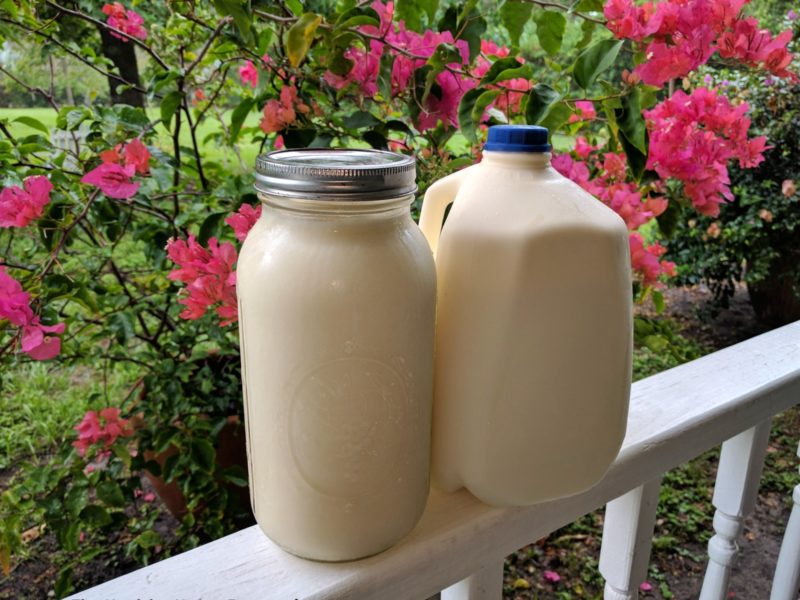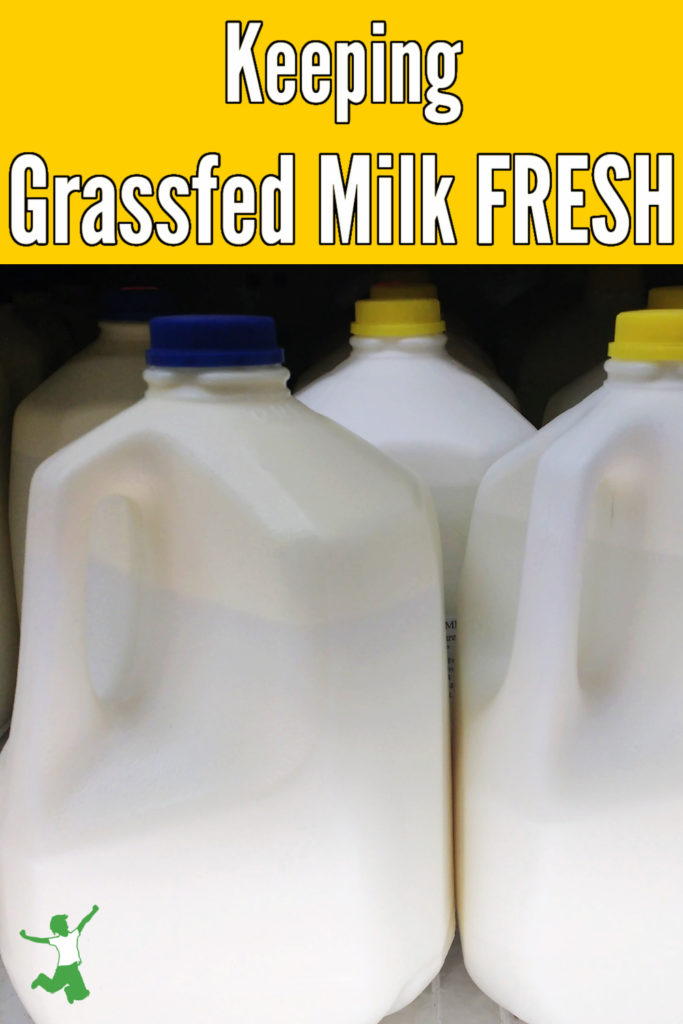How to keep grassfed raw milk fresh for drinking as long as possible so that your investment in Real Food is maximally used for your family’s health benefit.

When making the smart switch to unpasteurized milk from allergy-triggering pasteurized or ultrapasteurized (UHT) organic milk, a consumer needs to learn a few tricks of the trade right away. One of the most important is how to maintain raw milk freshness as long as possible.
Practically speaking, this is necessary because quality, fresh from the farm milk is usually at least double or even triple commercial milk prices (unless you buy at the farm and bring your own containers). You want every drop to stay fresh until you’ve used it up!
This is especially important for those who will use the grassfed milk for homemade baby formula.
As someone who has purchased and consumed raw grass-fed milk from over two dozen farms in many different states and countries over the past 2 decades, I thought I would pass along 5 important tips on how to make this happen in your home.
Quality, unpasteurized raw milk should easily remain fresh for drinking on average 10-14 days. In the summer, when the grass is mild and grows fast, I’ve found it will sometimes last 3 weeks or more.
If your farm doesn’t have milk that stays fresh this long, several things could be the problem.
A Large Creamline Locks in Raw Milk Freshness
The type of cow you get your milk from makes a huge difference to how long it lasts in the fridge.
Holstein (black and white) cows, produce milk with a decidedly small to nearly imperceptible cream line.
This is a problem for freshness because the larger the cream line, the longer the milk stays fresh for drinking. The cream very effectively locks in the freshness of the milk. Another related problem with Holstein milk is the A1 vs A2 cow genetics issue as discussed in the linked article.
Raw milk stays fresh much longer when you get it from old-fashioned cows such as jersey, guernsey, or devon among others.
If you’re not an expert at knowing a cow’s breed just by looking at her, then examine the cream line at the top of the milk.
If it isn’t at least an inch or usually two or more, then it’s probably from Holstein or Holstein-mix cows.
The cream line on the jersey milk I buy is regularly 1/3 the height of the container! No wonder this amazing milk stays fresh for so long.
Milking Protocol
Another reason for rapidly soured milk is the type of milking procedures used at the farm.
If a farm bottles the raw milk before it is cooled to 34-40 ºF/ 1-4 ºC, this can reduce how long the milk remains fresh for drinking by a few days or even a full week. The reason is that milk comes out of the cow at approximately 104 ºF/ 40 ºC. If this warm milk is put into a bottle immediately and then refrigerated, it will take HOURS for it to completely cool down.
The longer raw milk is above 40 ºF/ 4 ºC, the more rapidly it will sour. This occurs from the beneficial probiotic microbes consuming the milk sugar which gradually transforms it into a clabbered milk state.
On the other hand, rapidly cooling before bottling is a huge positive for raw milk freshness. As mentioned above, it will likely add a week or more to the drinkable life of the milk.
Bottling raw milk before it is cold is not necessarily a safety issue. It is, however, a less desirable approach. Rapid cooling before bottling ensures a quality product that lasts longer for the consumer.
Check Refrigerator Temperature
Another common reason raw milk sours quickly is due to consumer negligence. A refrigerator that stores raw milk really must be below 40 ºF/ 4 ºC. Every degree above 40 ºF/ 4 ºC will take at least a couple of days off the drinking life of the milk.
You absolutely cannot tell how cold a refrigerator is by opening it up and sticking your hand in there to gauge the temperature. The only reliable way is to measure it precisely with a fridge thermometer. I use this one.
Most people regularly have a fridge in the 40-45 ºF range and think everything is just fine. That is until they start to store raw milk and wonder why it only lasts a week or even less.
If you are having problems with maintaining raw milk freshness, please don’t complain to your farmer. At least not yet! Check your fridge first.
The ideal fridge temperature is 33-36 ºF. Even better, store bottles of raw milk that you aren’t actively using yet in a second fridge that is 33-36 ºF. This way you add the benefit of the door not getting opened and closed much which helps better maintain the optimal temperature range.
Glass Bottles are Best
Raw milk stays fresh longer in glass as opposed to plastic jugs. That said, many grass-fed farms do not offer their milk in glass bottles. This isn’t necessarily a problem.
For example, the farm I buy raw milk from only offers raw milk in plastic jugs. This is offset by the large cream line and rapid milk cooling system utilized at the farm.
If you can only get your raw milk in plastic jugs too, then simply transfer the milk into glass as soon as you get home. These inexpensive half-gallon jars work well in my experience.
You don’t have to do this, of course! Transferring milk to glass is just a helpful tip for extending the drinkable life of your raw milk. It is also a smart way to maintain raw milk freshness while you are out of town.
Freezing Raw Milk with Baking Soda
It is possible that the only raw milk available in your area is from Holstein cows, milked without modern cooling equipment, and packaged in plastic jugs.
If that is the case, you can try freezing raw milk instead of refrigerating it. This option works even if you use it to make homemade milk-based baby formula. I know a number of people that have used this approach for many years. They simply thaw one container at a time on an as-needed basis.
Freezing is also a smart approach if you need to drive a long distance to pick up your raw milk and are only able to make the trip every month or two.
The primary problem with freezing raw milk is that the cream sometimes gets a bit grainy when you thaw it out. This adds a slightly undesirable texture issue to each glass.
To avoid this problem, add 1/2 tsp baking soda to each gallon before shaking it up really well and then freezing. The baking soda helps to minimize or even eliminate any clumping of the cream when the milk is thawed.
Not sure what type of container to use for freezing? This article discusses tips on how to freeze milk in either plastic or glass with no mess or safety issues.
Do you have any other tips for maintaining unpasteurized raw milk freshness? Please share it with all of us!








I know it’s pretty obvious, but since no one mentioned it I will; by all means bring a cooler chest with you when you pick up your milk. A single half hour in a car is enough to raise the temp several degrees. If you’re going to be an hour or more, which is likely, add ice.
Would baking soda possibly have an antimicrobial effect, too?
A small amount of baking soda added before freezing raw milk to prevent clumping of the thawed cream is fine. Baking soda won’t harm the probiotics from what I’ve researched. A small amount of baking soda is actually recommended by some practitioners to mix with probiotics to help neutralize the effects of stomach acid to encourage the probiotics to make it intact to the intestines.
How about colloidal silver to help keep milk fresh longer?
Definitely not. Colloidal silver is a natural antibiotic and destroys the good probiotics in raw milk! It also destroys them in your gut, which is why I only ever use it as an external antibiotic. https://www.thehealthyhomeeconomist.com/never-consume-colloidal-silver/
Use induction cooktop on low to thaw out frozen milk.
I don’t recommend induction cooktops due to the radiation dangers. https://www.thehealthyhomeeconomist.com/induction-stove-dangers-what-to-buy-instead/
How to Keep Your Raw Milk FRESH!
youtu.be/2K9pUQ-cycs
Very helpful tips as always. Thank you, Sara!
Hi Sarah,
I am thinking about switching my family to raw milk as it has more nutrients than the regular processed stuff. However I am also worried about the levels of natural hormones
that reside in the cream portion of raw whole milk. I heard of a couple of stories where the young women who had switched to raw whole milk/dairy and their breasts grew very quickly in size. I have a 11 year old daughter and I don’t want her to have large breasts by the time she is 14. Should we purchase raw skimmed milk instead?
Thanks!
Clare
I have honestly never heard of this ever except in relation to commercial processed milk which is loaded with steroids and hormones. Skim milk is not a good option! Skim milk is far more likely to make you fat. https://www.thehealthyhomeeconomist.com/why-skim-milk-will-make-you-fat-and/
I make yogurt to use up extra milk before it goes bad. If it’s on the edge, tastewise, I make chocolate milk. I do sweeten it but I don’t use nearly the amount of sugar as commercial chocolate milk.
An idea for those who have a distance to drive for raw milk: for a couple of years, we organized a milk group. There were four or five other families and we took turns driving. I printed a schedule with everyone’s standing order and phone number and assigned driving date and it worked pretty well.
Do these same principles hold true for sheep or goat’s milk?
Yes they do.